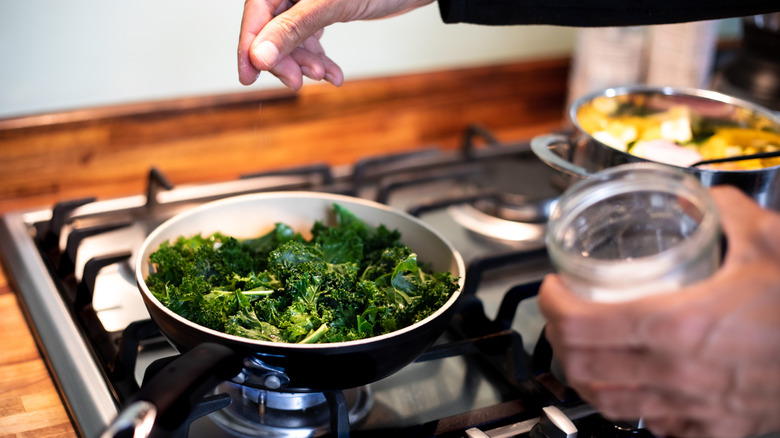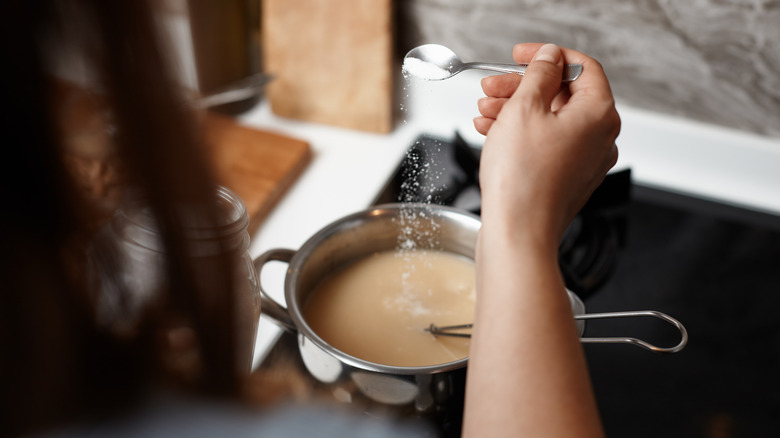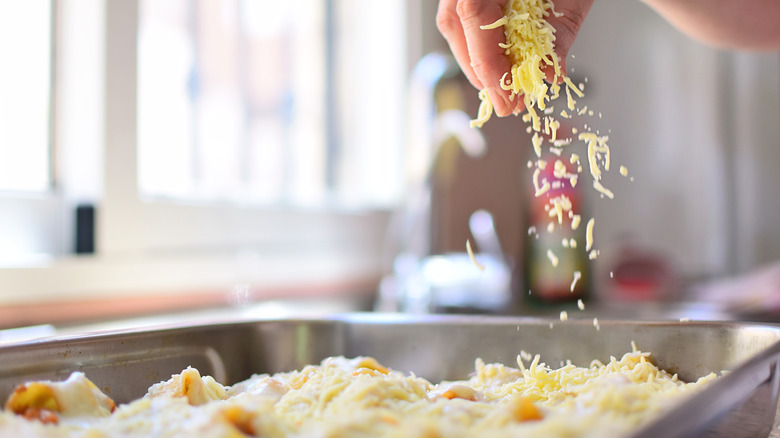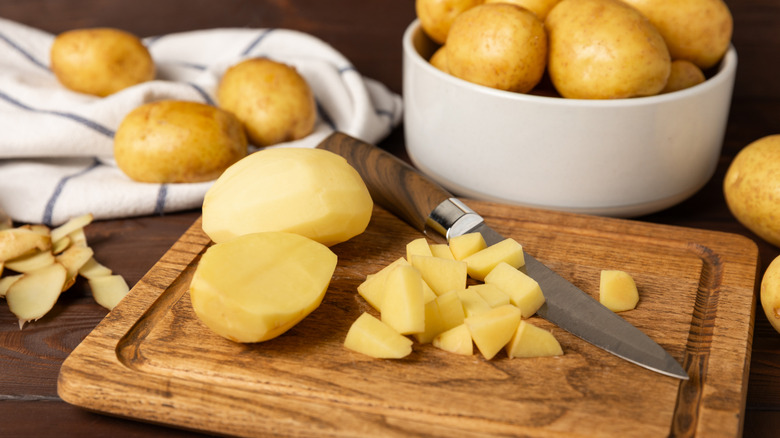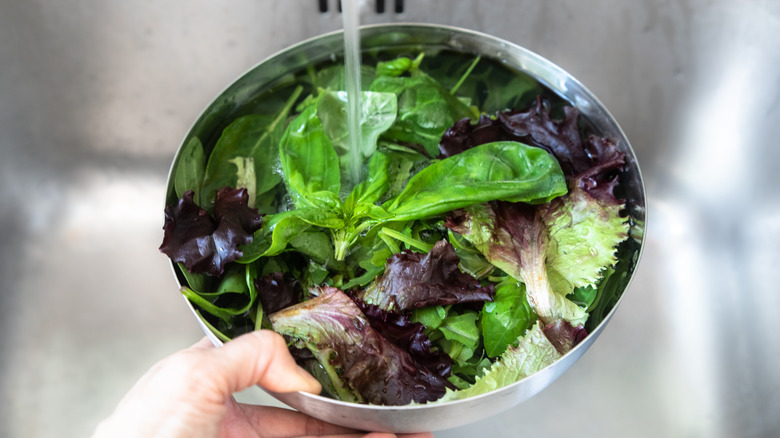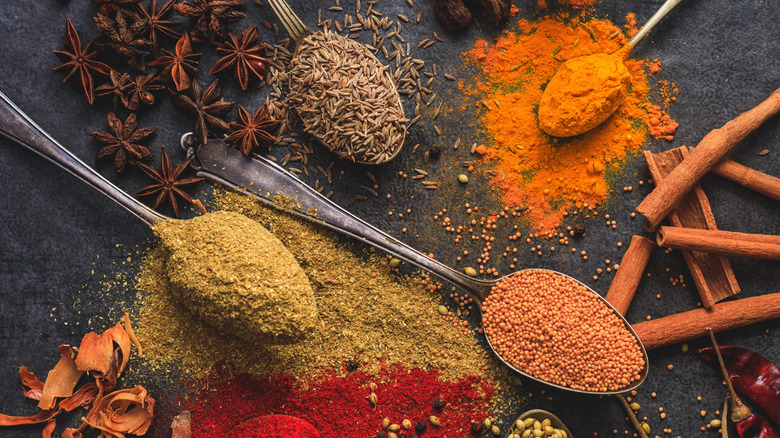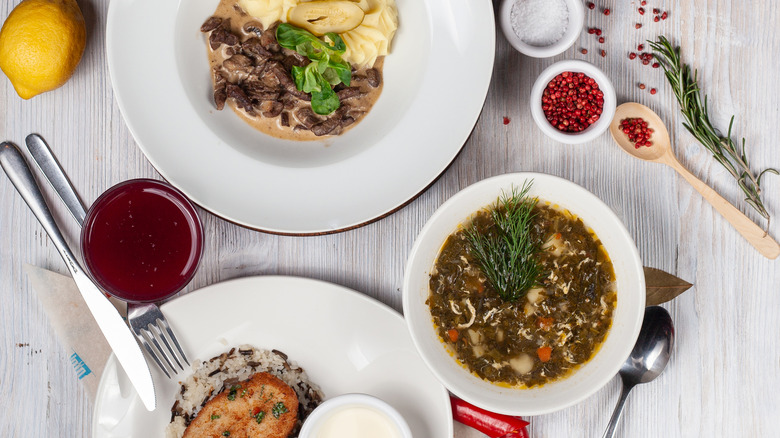10 Tips Chefs Swear By For Fixing Overly Salty Food
It happens more often than you think. An extra pinch of salt and suddenly your meticulously prepared meal is ruined. But, before you panic and bin the entire thing, there are still a few ways to save the day. With a little kitchen wisdom and some speedy intervention, even the saltiest of meals can be rescued.
To break it down for us, we asked two seasoned culinary experts who know a thing or two about preventing kitchen meltdowns. Chef Bill Rosenberg, a Culinary Institute of America graduate with over 35 years of global kitchen experience, brings his expertise in flavor balance and sustainable cooking. Known for his signature dishes at acclaimed restaurants like F.I.S.H. and NoMa Social, Rosenberg now leads the kitchen at Constantino's Pasta Bowls, where he continues to craft elevated, comforting fare for families and food lovers alike. Joining him is chef Cristina Ferrare, a celebrity chef, bestselling cookbook author, and former talk show host. Ferrare's culinary voice blends heart, home, and style, drawn from decades of experience both in front of the camera and in the kitchen. They both share their most practical tips for making one of the most common cooking mishaps taste both intentional and delicious.
1. Dilute the recipe
This is probably the easiest way to fix over-salted food and works well with soups, stews, and sauces. As chef Bill Rosenberg explains, "Diluting the dish will reduce the concentration of salt in the dish as you add more of the base. Ingredients that are starch-heavy will absorb liquid and disperse the salt throughout the dish, evening out the salty taste." He advises adding "more of the unsalted base, such as broth, water, tomatoes, cream ... to dilute the dish." Chef Cristina Ferrare is a fan of this tip as well, "When a dish is too salty, my first move is to dilute it by adding more unsalted liquid, like water, broth, or cream, depending on the recipe. Another simple trick is to add more of the main ingredients to help absorb the excess salt and restore balance. The goal is always to bring the flavors back into harmony without compromising the dish."
Chef Ferrare further explains, "Saltiness comes down to concentration: too much salt in too little food. By adding more liquid or unsalted ingredients, you're increasing the overall volume, which naturally spreads out the salt and makes the dish taste less salty." Chef Rosenberg cautions, though, "Dilution is the most straightforward way to correct saltiness ... After this, it's just a matter of adjusting the other seasonings accordingly to rebuild the depth of the dish. The key is to stretch the dish without flattening the taste completely."
2. Add a touch of sweet
Sweet to counter salt? Seems too easy, doesn't it? "Yes, a touch of sweetness can help balance out saltiness," says chef Cristina Ferrare. This is because sugar helps balance out salt, so they naturally offset each other. This is a principle chefs use to create depth and harmony in most recipes.
You can use white or brown sugar, or any sweet agent like honey or maple syrup. The choice of sweetening agent is up to you, but be aware, the one you choose can affect the final taste of the dish. Brown sugar or maple syrup will impart a caramel flavor to your dish, while white sugar will bring a more neutral sweetness, so choose based on what suits the overall profile of the dish. This method works best in savory dishes. If your recipe is already sweet, like a dessert, you may need to rely on other techniques to tone down the salt.
You will not need too much sugar, though. Start by adding a pinch at a time and taste the dish between additions so that you don't over-correct. "I've used a pinch of sugar, a drizzle of honey, or even a bit of maple syrup, but always sparingly. It won't remove the salt, but it can soften the sharpness and bring the flavors back into balance without making the dish taste sweet when used in moderation," shares chef Ferrare.
3. Increase the acidity
Adding an acidic ingredient to your food is another way to neutralize the saltiness. It can add a touch of tanginess to your dish without changing the flavor profile. But don't expect miracles. "Acid-based ingredients won't remove salt, but instead stimulate other taste receptors and balance out our perception of saltiness in the dish. A squeeze of lemon or a spoonful of white wine vinegar can brighten dishes like a salty cream sauce to shift the palate away from saltiness," cautions chef Bill Rosenberg.
An acidic agent, such as lemon, orange juice, or vinegar, can effectively balance out the saltiness. Since tomatoes are acidic, a tomato paste will also work. You will have to choose an ingredient that will go well with the flavor profile of your dish. For example, lime juice would be better suited to carnitas, not balsamic vinegar. If in doubt, choose a neutral tasting agent such as white wine vinegar or rice vinegar, as these go well with a lot of dishes. Chef Rosenberg elaborates, "The acid can lift flavor to rebalance a dish that has that sharp salty taste. However, it's important to always make sure to add acid in small amounts, and taste after each addition to get the flavors just right." Add a little at a time so as not to overwhelm the other flavors. Stir well and taste before deciding if the dish needs any more.
4. Up the fat content
Adding fat to your dish has the effect of coating your tongue and acting as a barrier for your taste buds. The result? Your dish tastes less salty, even though the salt content has not been reduced. Chef Bill Rosenberg is a fan, "Fat is an excellent tool for softening a harsh salty taste. Fat will smooth flavors by physically coating your taste buds, which dulls our perception of the salty taste." If your dish already contains dairy, add some cream, cream cheese, or milk. For non-dairy-based dishes, you can add a cream-based topping or side. Sour cream for salty meat-based dishes or as a side with mayonnaise will work very well.
Adding a mild, soft, shredded cheese such as mozzarella or burrata (not the same thing) can also help to mask the saltiness. Be sure not to use salty cheeses like cheddar or feta. If it's a non-dairy option you need, then a mashed avocado will do the trick. Chef Cristina Ferrare says dairy helps her "to soften salty flavors. I've used milk, cream, sour cream ... or even unsalted cheese to mellow out a dish. These ingredients add balance, helping to tone down the salt without overpowering the original flavors." The creaminess will mask the saltiness, with a bonus of making your dish taste richer. Chef Rosenberg sums it up, "In dishes like soups or mashed potatoes, adding butter or cream can rescue them when they're overly seasoned. In a curry, coconut milk is a game-changer."
5. Add some yogurt
When a dish seems too salty, a spoonful (or two) of yogurt could be exactly what saves the day. Dairy products like Greek yogurt or skyr help mellow excessive saltiness by upping the creaminess of the dish. Additionally, yogurt introduces a subtle acidity that only helps matters with the slight tang providing a balancing contrast to excess salt. As explained by our experts earlier, like cheese and cream, the fat in yogurt coats the tongue, muting sharp or intense flavors, helping dilute the concentration of salt per bite. This is especially true when used to remedy liquid-based recipes like soups, curries, and stews.
Chef Cristina Ferrare agrees, "Yes, I've used yogurt to help tone down overly salty soups and stews. It adds a gentle creaminess and a slight tang that can balance the flavors nicely. I always add it a little at a time and taste frequently, it's all about finding that sweet spot without overwhelming the dish." It's especially effective when stirred in just before serving or dolloped on top as a final flourish. Chef Bill Rosenberg adds, "Yogurt and sour cream work best in curry, stew, or Middle Eastern dishes since they add a tang and moisture to the dish." In other words, it's not just about softening the salt but more about restoring balance and texture without compromising the integrity of the recipe.
6. The magic of a potato?
Is the humble potato the magic fix for over-salted food? There are two schools of thought on this. One group believes that adding a whole potato, skin on, to the pot while your dish is cooking (and removing the potato before serving) will help absorb some of the excess salt. That said, leave the potato in too long, and it can break down into mush. Through trial and error, many find that 20 to 30 minutes is the sweet spot.
However, there is another group of chefs who remain skeptical about how much salt is actually absorbed. For them, adding a potato could be a low-risk fix that's worth a try or as chef Bill Rosenberg points out, "You can also add more starchy ingredients to absorb some salt such as incorporating rice, pasta, beans, or even bread. Tossing in a raw potato to 'absorb' salt in a dish also doesn't work reliably as the potato will absorb the liquid in the dish, not decrease the concentration of the salt ... This trick is more kitchen folklore than science; it's much better to add bulk with low-sodium ingredients than gamble on a potato." Chef Cristina Ferrare acknowledges that, "The idea of using potatoes to 'soak up' excess salt has been around a long time, but in my experience — and according to research — it's not a reliable fix. Potatoes may absorb some liquid, but they won't pull enough salt from the dish to make a real difference."
7. Rinse it off
Sometimes, the simplest fix for overly salty food — and we know this might sound strange — is to just rinse it off. Hear us out. Firstly, this works best with ingredients like rice, vegetables, or meat. If they have been cooked individually and seasoned, it gets even easier to try this hack out. Place the meat or veggies in a sieve and run under cold water to wash off the excess salt. In the case of dishes such as over-salted beans or lentils, a quick soak in plain water followed by draining can help dilute the salt content.
Now, if the excessive salting happens after a dish has been prepped or plated, you need to move fast and scoop the extra salt off. Use a spoon and remove the offending crystals as soon as possible (before they dissolve into the food). For dry foods like grilled vegetables, roast chicken, or even a steak, a basting brush can help sweep away surface salt, or try patting the area gently with a damp paper towel to lift the salt without affecting the texture too much. The key, as with all kitchen fixes, is to act quickly and avoid panic. In more cases than not, there's almost always a way to bring balance back to your dish.
8. Reseason
If you've tried a lot of the tricks but the saltiness is going nowhere, there are still a few wildcard options available. For example, have you thought of balancing the saltiness with other spices? The reasoning behind this is that over-salting food often dulls the overall flavor profile of a recipe. Adding a new layer of bolder spices or aromatics (just ensure they are fresh) could help not only distract the palate from the saltiness but also restore the complexity of the dish. In such cases, spices such as paprika, coriander, cumin, or chili powder can help round out the flavor. Using honey or sugar can balance out the salty sharpness of a recipe and round off the taste of the dish.
There is also an Indian cooking technique known as tarka (or tempering) where you sauté the aromatics such as garlic, ginger, cumin, or chilis in oil or ghee. Once fragrant and piping hot, you add this mixture into your dish, just before serving. It's a wonderful way to add a burst of seasoning and help transform a ruined meal into a savory masterpiece. Chef Bill Rosenberg concurs, "I reseason with ingredients that are low in salt. To reintroduce the complexity to the dish, I'll add fresh herbs, aromatics like garlic or onion, or umami boosters like miso or mushrooms. The key balance is to rebuild the character of the dish without falling back into over-seasoned territory."
9. Balance it out with the rest of your meal
When adjusting your main dish isn't enough, a clever way to work around the problem is to distract and deflect. What do we mean by this? Well, as a last resort, you could balance out the salinity of the dish by serving it with simple, (slightly) under-seasoned sides that help balance out the entire meal. If you are struggling with a particularly briny stew or overly salted roast, chef Cristina Ferrare says, "Simple side dishes like plain rice, pasta, or polenta are great for balancing out a salty main. They don't add more salt and help absorb some of the flavor, making each bite more mellow."
These will help soak up any extra gravy or sharp sauces. Other alternatives include mashed or fluffy baked potatoes, but stay away from the salted butter and seasonings. Crusty bread will do the trick as well to dilute the intensity of the main dish. Instead, lean into mild, dare we say, bland staples that let the main dish shine without competing with it. "Side dishes are a safety net when the main dish can't be fully fixed. For example, if a protein or stew is too salty, serve it with plain rice, bread, or a vegetable puree. This evens out the taste of the meal," shares chef Bill Rosenberg.
10. Add some fizz
If you're hosting and still afraid to overwhelm your guests with an unbalanced meal, you could offer them a sparkling drink to help refresh the palate between bites. This also helps soften the harshness of the overly salted meal; a light fizzy drink can help stabilize the taste buds and make the meal more enjoyable. Light bubbles like prosecco, Champagne, sparkling rosé, or even plain seltzer work best in such cases. When asked if drink pairings make a difference, chef Cristina Ferrare had this to say, "Absolutely ... while they won't remove the salt, the right beverage can help balance the overall experience. Sparkling water or a light, crisp wine or beer can refresh the palate and tone down the intensity of the saltiness, making the meal feel more harmonious."
As an aside, adding certain types of alcohol can be used to fix a salty gravy. While alcohol does not work as an acidic agent here, it does work by adding another subtle layer to the flavor profile of the dish. For gravy and soup, try a dry white wine or even a brandy and sherry for a change.
